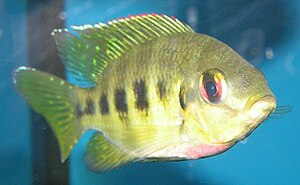Marienbuntbarsch
| Marienbuntbarsch | ||||||||||||
|---|---|---|---|---|---|---|---|---|---|---|---|---|

Marienbuntbarsch ( Pelmatolapia mariae ) |
||||||||||||
| Systematics | ||||||||||||
|
||||||||||||
| Scientific name | ||||||||||||
| Pelmatolapia mariae | ||||||||||||
| ( Boulenger , 1899) |
The Marienbuntbarsch ( Pelmatolapia mariae ) is a species of fish from the family of the cichlids (Cichlidae), which occurs in western Africa from the Ivory Coast to Cameroon in coastal rivers and lagoons. In the distribution area there is a gap between the Pra in Ghana and Benin .
features
Pelmatolapia mariae can grow to over 30 cm in length, but usually stays around 17.5 cm in length. He has a very high back and laterally flattened body. The body height is 46.9 to 51.6% of the standard length , the head length 29.7 to 34.7% of the standard length. The head profile is rounded. The jaws are covered with 3 to 6 rows of teeth, the teeth of the outer row of teeth are spade-shaped and two-pointed. The teeth of the lower pharyngealia are small and narrow and form a felt-like coating close to the posterior edge of the bone. On the gill arches there are micro gill trap rays and twelve or more gill trap rays on the lower branch of the first gill arch.
Young Marian cichlids are yellowish, sometimes with a reddish belly, and show 7 to 9 vertical dark bands on the sides of the body (characteristic of the genus Pelmatolapia ). Adult fish longer than 15 cm are green-yellow with a whitish belly and olive-green on the top of the head. There are 5 to 6 dark spots on their sides, which are closer together towards the back. Below the sideline , the scales are often marked with a central red dot. The unpaired fins are greenish and reddish between the soft rays. The dorsal fin is lined with reddish tones.
- Fin formula : dorsal XV-XVII / 13-15, anal III / 10-11.
- Scale formula : SL 29-31.
Way of life
The Marienbuntbarsch occurs mainly in stagnant water and calm river sections over rocky or muddy bottoms. It feeds mainly on plants and algae. The fish become sexually mature with a length of 10 to 15 cm. Like all tilapia species, they are substrate spawners . The 300 to 600 eggs and the young fish that hatch after one to three days are guarded by both parents and brood care continued until the young fish are around 2.5 to 3 cm long.
Systematics
The species was described in 1899 by the British ichthyologist George Albert Boulenger and assigned to the subgenus Pelmatolapia . The subgenus Pelmatolapia was raised to genus rank in early 2013.
literature
- Melanie Stiassny, Guy Teugels & Carl D. Hopkins: The Fresh and Brackish Water Fishes of Lower Guinea, West-Central Africa. Volume 2, ISBN 9789074752206
Individual evidence
- ^ Andreas R. Dunz, Ulrich K. Schliewen: Molecular phylogeny and revised classification of the haplotilapiine cichlid fishes formerly referred to as “Tilapia”. Molecular Phylogenetics and Evolution, Doi: 10.1016 / j.ympev.2013.03.015
Web links
- Pelmatolapia mariae on Fishbase.org (English)